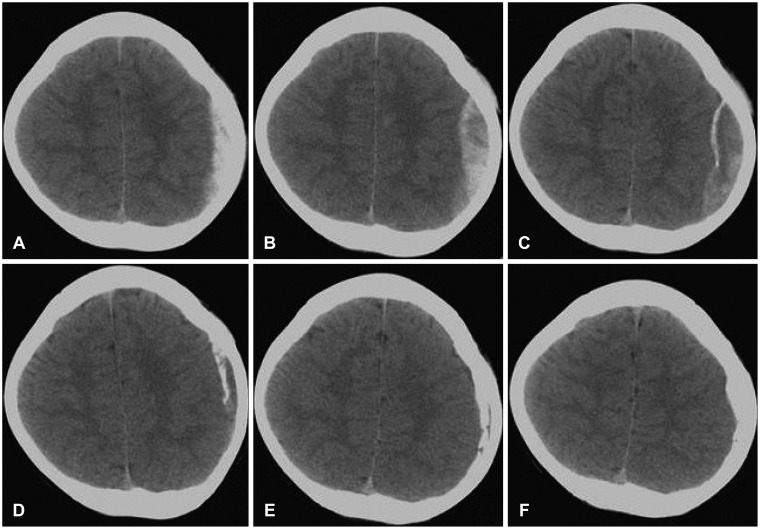Korean J Neurotrauma.
2014 Oct;10(2):152-154. 10.13004/kjnt.2014.10.2.152.
Rapid Ossification of Epidural Hematoma in a Child: A Case Report
- Affiliations
-
- 1Department of Neurosurgery, School of Medicine, Kosin University, Busan, Korea. ysparkns@kosinmed.or.kr
- KMID: 2256258
- DOI: http://doi.org/10.13004/kjnt.2014.10.2.152
Abstract
- The author present a rare case of rapid ossification of epidural hematoma (EDH) in a 5-year-old boy. At admission, the computed tomography (CT) revealed an EDH on left temporoparietal region. On the follow-up CT scan doing 14 days after traffic accident, the expansion of the former hematoma was not visible, but the hematoma accompanied by the thin hyperdense layer on the dura. On follow-up CT scans, the hematoma was decreased but the ossified layer progressing. After 6 months of conservative therapy, the hematoma was fully absorbed and the ossified lesion merged to inner table of the skull. Hence, rapid ossification of an EDH should be considered in children and serial follow-up CT scans must be conducted.
MeSH Terms
Figure
Reference
-
1. Ahn DH, Eom KS, Kim DW, Park JT, Moon SK, Kang SD, et al. Traumatic Acute Epidural Hematoma in Children. J Korean Neurotraumatol Soc. 2009; 5:11–15.
Article2. Cambria S, Marra GA, Di Perri R, Bramanti P. Ossified epidural hematoma. Report of a case with epilepsy. J Neurosurg Sci. 1985; 29:285–288. PMID: 3831274.3. Erdogan B, Sen O, Bal N, Cekinmez M, Altinors N. Rapidly calcifying and ossifying epidural hematoma. Pediatr Neurosurg. 2003; 39:208–211. PMID: 12944702.
Article4. Iwakuma T, Brunngraber CV. Extradural ossification following an extradural hematoma. Case report. J Neurosurg. 1974; 41:104–106. PMID: 4210068.5. Kawata Y, Kunimoto M, Sako K, Hashimoto M, Suzuki N, Ohgami S, et al. [Ossified epidural hematomas: report of two cases]. No Shinkei Geka. 1994; 22:51–54. PMID: 8295702.6. Mathuriya SN, Kak VK, Banerjee AK. Ossified epidural haematoma. Report of two cases. Clin Neurol Neurosurg. 1989; 91:269–272. PMID: 2548795.7. Nagane M, Oyama H, Shibui S, Nomura K, Nakanishi Y, Kamiya M. Ossified and calcified epidural hematoma incidentally found 40 years after head injury: case report. Surg Neurol. 1994; 42:65–69. PMID: 7940099.
Article8. Sakai N, Yamamori T, Tanemura H, Yamada H, Shimokawa K. [Calcified epidural hematoma-report of a case incidentally found 16 years after head injury (author's transl)]. No Shinkei Geka. 1977; 5:163–167. PMID: 557736.9. Shim KW, Chang JH, Chang JW, Park YG, Kim TS, Chung SS. Chronic epidural hematoma with ossification: a case report. J Korean Neurosurg Soc. 2001; 30:943–946.10. Yoshida N, Iseki H, Amano K, Kitamura K. [A case with postoperative calcified epidural hematoma]. No Shinkei Geka. 1985; 13:1199–1203. PMID: 4088442.
- Full Text Links
- Actions
-
Cited
- CITED
-
- Close
- Share
- Similar articles
-
- Chronic Epidural Hematoma with Ossification: A Case Report
- Spontaneous Spinal Epidural Hematoma Associated with the Ossification of Ligamentum Flavum of the Thoracic Spine
- Spontaneous Rapid Resolution of Acute Epidural Hematoma in a Neonate
- Acute Traumatic intracranial Epidural Hematoma in a 4-month-old Infant after a Fall down: A Case Report
- Thoracolumbar Epidural Hematoma Complicated by Cauda Equina Syndrome : Complication of Systemic Heparinization Following Epidural Anesthesia: A case report


